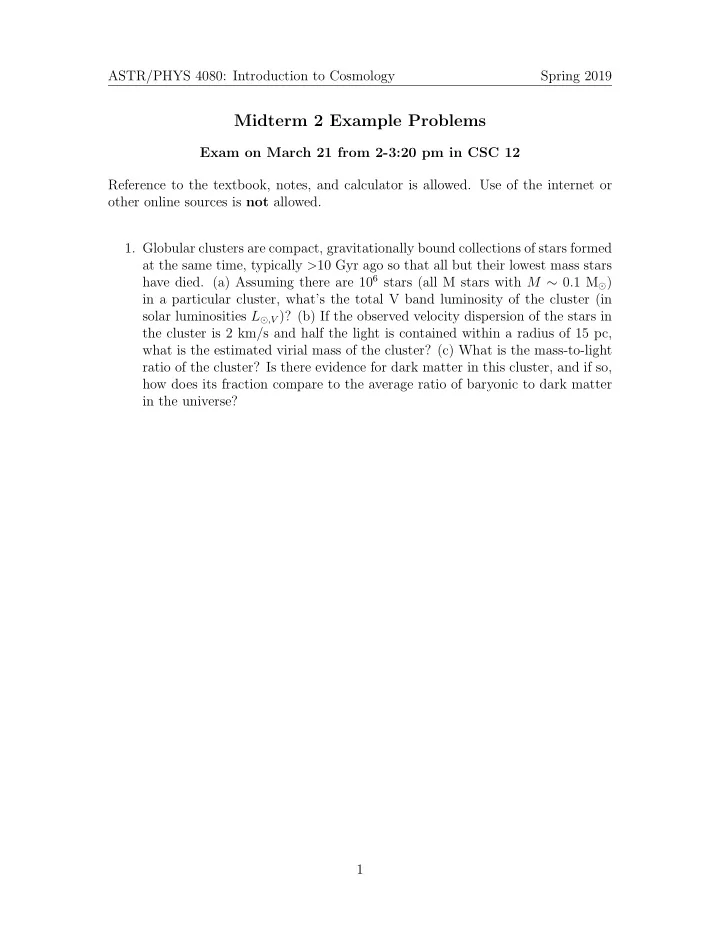

ASTR/PHYS 4080: Introduction to Cosmology Spring 2019 Midterm 2 Example Problems Exam on March 21 from 2-3:20 pm in CSC 12 Reference to the textbook, notes, and calculator is allowed. Use of the internet or other online sources is not allowed. 1. Globular clusters are compact, gravitationally bound collections of stars formed at the same time, typically > 10 Gyr ago so that all but their lowest mass stars have died. (a) Assuming there are 10 6 stars (all M stars with M ∼ 0 . 1 M ⊙ ) in a particular cluster, what’s the total V band luminosity of the cluster (in solar luminosities L ⊙ ,V )? (b) If the observed velocity dispersion of the stars in the cluster is 2 km/s and half the light is contained within a radius of 15 pc, what is the estimated virial mass of the cluster? (c) What is the mass-to-light ratio of the cluster? Is there evidence for dark matter in this cluster, and if so, how does its fraction compare to the average ratio of baryonic to dark matter in the universe? 1
ASTR/PHYS 4080: Introduction to Cosmology Spring 2019 2. (a) Write down the Friedmann equation in terms of a , the current density parameters Ω i , 0 (where i stands for the particular component), H 0 , and the Hubble parameter for a universe with radiation, matter, and cosmological con- stant components. In other words, the version that uses the definition of the critical density and a substitution for the curvature to simplify the equation. (b) Rearrange the equation so that it has the functional form t ( a ) equal to an integral expression. (c) Consider 3 universes, all flat, in which only one com- ponent dominates: radiation, matter, or dark energy. How does a ( t ) depend on t and what is Ω i , 0 equal to in each case? 2
ASTR/PHYS 4080: Introduction to Cosmology Spring 2019 3. Imagine a universe composed of matter and dark energy only, where the current density parameters relative to the critical density are Ω m , 0 = 0 . 5 and Ω DE , 0 = 0 . 5, which has the equation of state parameter w DE = − 1 / 2. (a) Is this universe accelerating, decelerating, or expanding at a constant rate at the current time? (b) What’s the approximate proper distance d p ( t 0 ) to a galaxy at a redshift z = 0 . 1 (assume H 0 = 70 km/s/Mpc)? (c) How does this compare to the distance predicted by Hubble’s law? 4. Two galaxies next to each other on the sky have distance moduli that differ by a factor of 10 [i.e., ∆( m − M )=10]. How many times farther away is the more distant galaxy from us than the more nearby galaxy is from us? 3
ASTR/PHYS 4080: Introduction to Cosmology Spring 2019 5. Assume the universe is spatially flat and is dominated by non-relativistic matter during and after the last scattering of CMB photons (and that the physics and timing of recombination remains unchanged). In this universe without dark energy, what is the angular scale θ s of the first peak in the CMB power spectrum? 4
Recommend
More recommend